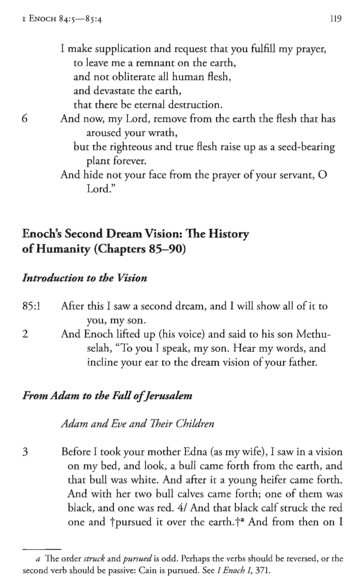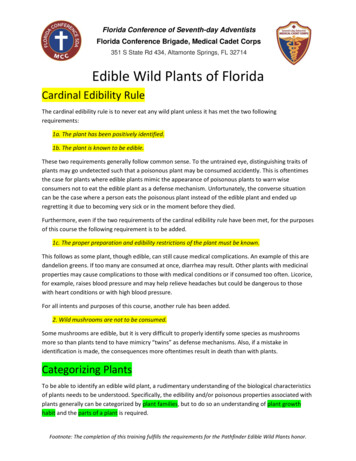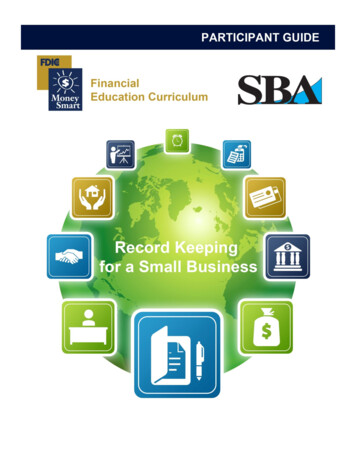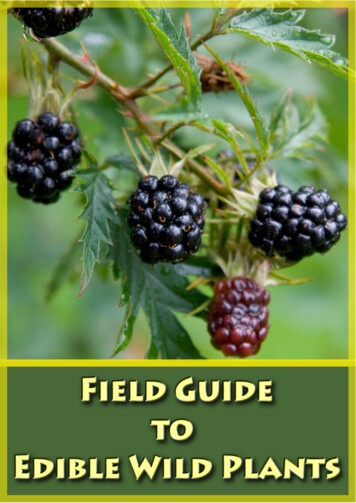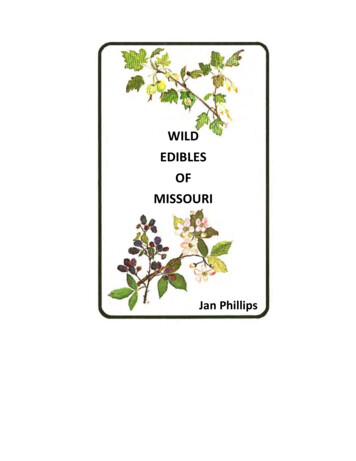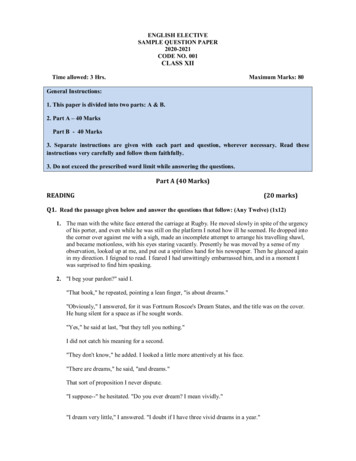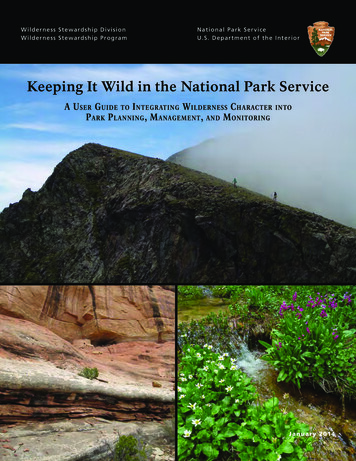
Transcription
Wilderness Stewardship DivisionWilderness Stewardship ProgramNational Park ServiceU.S. Department of the InteriorKeeping It Wild in the National Park Servicea U Ser g Uide to i ntegrating W ilderneSS c haracterp arK p lanning , M anageMent , and M onitoringintoJanuary 2014
Cover photos:(Top) NPS/Suzy Stutzman, Great Sand Dunes Wilderness, Great Sand Dunes National Park(Left) NPS/Peter Landres, recommended wilderness, Canyonlands National Park(Right) NPS/Peter Landres, recommended wilderness, Cedar Breaks National Monument
Keeping it Wild in the national parK Servicea USer gUide to integrating WilderneSS character intoparK planning, ManageMent, and MonitoringDeveloped by the National Park Service Wilderness Character Integration Team withfunding and support from the NPS Office of Park Planning and Special Studies and theWilderness Stewardship DivisionA Companion Document to the 2014Wilderness Stewardship Plan Handbook:Planning to Preserve Wilderness CharacterWASO 909/121797; January 2014
execUtive SUMMaryThis User Guide was developed to help National Park Service (NPS) staff effectively andefficiently fulfill the mandate from the 1964 Wilderness Act and NPS policy to “preservewilderness character” now and into the future. This mandate applies to all congressionallydesignated wilderness and other park lands that are, by policy, managed as wilderness,including eligible, potential, proposed, or recommended wilderness. This User Guide buildson the ideas in Keeping It Wild: An Interagency Strategy to Monitor Trends in WildernessCharacter Across the National Wilderness Preservation System (Landres and others 2008). TheUser Guide offers practical guidance and tools to integrate wilderness character into parkplanning, management, and monitoring, and is divided into six chapters and a companiondocument: Chapter 1, Introduction to the User Guide and Wilderness Character—Describes thecontext for why wilderness and wilderness character are important and the specialrole of the National Park Service in its preservation; defines the concept of wildernesscharacter and the general benefits of its integration into planning, management, andmonitoring. Chapter 2, Building Blocks for Integrating Wilderness Character—Describes thefundamental information needed to effectively integrate wilderness character intopark planning, management, and monitoring. Chapter 3, Integrating Wilderness Character into Planning—Describes how to addresswilderness character in a park foundation document and selected park planningproducts, which can serve as examples for other types of planning efforts. Chapter 4, Integrating Wilderness Character into Management and Operations—Describes how wilderness character relates to NPS Director’s Order 41: WildernessStewardship, staff training, minimum requirements analysis, scientific activities,environmental compliance, emergency services, and natural and cultural resources. Chapter 5, Monitoring Change in Wilderness Character—Describes how to identifyand prioritize measures to assess current conditions and track change in wildernesscharacter over time in a park in a way that is nationally consistent and locally relevant. Chapter 6, Emerging Tools to Integrate Wilderness Character—Describes several newtools that are still being developed, including: wilderness character mapping, thewilderness character monitoring database, and evaluating the “extent necessary” forcommercial services. Other tools will be added as they are developed. Wilderness Stewardship Plan Handbook 2014—Describes the development andcomponents of a wilderness stewardship plan driven by the concept of wildernesscharacter. The Handbook is a standalone document not included within the UserGuide, but directly associated with it.The User Guide is not prescriptive but instead offers a wide range of guidance and toolsfor incorporating wilderness character into park planning, management, and monitoring.Each chapter may be used in any order that makes the most sense. On page xii, the table“Where Can I Find What I Need?” enables quick reference to topics of interest. In addition,worksheets and examples are included in the User Guide and are also on the NPS WildernessCharacter tab under the Wilderness Stewardship Program Sharepoint site i
acKnoWledgMentSDeveloping Keeping It Wild in the National Park Service: A User Guide to IntegratingWilderness Character into Park Planning, Management, and Monitoring and theaccompanying Wilderness Stewardship Plan Handbook: Planning to Preserve WildernessCharacter would not have been possible without the vision, funding, and support of PatrickGregerson, NPS Office of Park Planning and Special Studies, and Garry Oye, NPS WildernessStewardship Division.The User Guide was developed by the Wilderness Character Integration Team. All themembers of this Team generously gave their time and effort to openly and civilly discuss anddebate, argue, consider other viewpoints, and finally reach consensus on literally hundredsof issues. All the members of this Team contributed their vision, passion, and 234 yearsof combined on-the-ground experience to write the User Guide. These team members, inalphabetical order, are Michael Bilecki, Carol Cook, Sarah Craighead, Jeremy Curtis, TimDevine, Sandee Dingman, Michael Haynie, Chris Holbeck, Chip Jenkins, Peter Landres,Adrienne Lindholm, Melissa Memory, Christina Mills, Ray O’Neil, Ruth Scott, Miki Stuebe,Suzy Stutzman, Karen Trevino, Frank Turina, and Wade Vagias.Dozens of other people were instrumental in producing the User Guide. Of particularnote, Mary Lucid used her accounting acumen to make it all happen, Erin Drake was theconsummate professional helping in enumerable ways to ensure that the User Guide wassuccessfully completed, and Ángel López made the User Guide look so good.The Team is extremely grateful to several people who helped write various sections in theUser Guide: Dave Vana-Miller helped write the “Resource Stewardship Strategy” section inchapter 3, Don Weeks helped with the climate change section in chapter 3, and Jeff Manleyhelped write the initial draft of the fire management plan section in chapter 4.Several people helped with their insight, expertise, and patience to integrate wildernesscharacter with cultural resources (Jill Cowley, Michele Jesperson, Sande McDermott, andJeff Rasic), and foundation documents (Sarah Conlin and Tokey Boswell). In addition, thefirst group of NPS Wilderness Fellows in 2010 (Monica Patel, Emily Biesecker, ChristinaMills, Lisanne Petracca, Katie Hawks, Alicia Burtner, and Brian Tarpinian) helped lay thefoundation for several of the tools offered in the User Guide with their passion, insight,and creativity.The Team sincerely appreciates all the time and effort of the reviewers who providedcomments on the April 2012 version of the User Guide and the Handbook that was releasedfor comment on the Planning, Environment, and Public Comment (PEPC) planning tool:Kenneth Biddle, Susan Dolan, Michael Edwards, Mark Husbands, Michael Rees, Bruce Rogers,Danny Rosencrans, Sam Tamburo, Dave Trevino, Dave Vana-Miller. In addition to theseindividuals, the Intermountain Regional Wilderness Executive Committee and the AlaskaRegional Cultural Resources Team provided many substantial and helpful review comments.iv
The Team also greatly appreciates all the comments from the staff at all the units that wereformal pilot test sites for the User Guide: the Denver Service Center, Death Valley NationalPark, Fire Island National Seashore, Glacier Bay National Park and Preserve, Olympic NationalPark, Pinnacles National Park, Rocky Mountain National Park, Sequoia and Kings CanyonNational Parks, and Mojave National Preserve.Many of the ideas presented in the User Guide were informally piloted tested and honedby many parks that participated early-on in different workshops. The Team is extremelygrateful to all of the superintendents and staff at these parks for their willingness to beearly adopters and engage in a little experimentation to figure out what works and whatdoesn’t. These parks, in rough chronological order, were: Haleakala National Park, BlackCanyon of the Gunnison National Park, Everglades National Park, Guadalupe MountainsNational Park, Buffalo National River, El Malpais National Monument, Fire Island NationalSeashore, Lassen Volcanic National Park, Death Valley National Park, Glacier Bay NationalPark and Preserve, Lake Clark National Park and Preserve, Gates of the Arctic NationalPark and Preserve, Sequoia and Kings Canyon National Parks, Zion National Park, OlympicNational Park, North Cascades National Park, Dinosaur National Monument, Noatak NationalPreserve, Rocky Mountain National Park, Saguaro National Park, and Denali National Parkand Preserve.Russ Cash from Zion National Park graciously provided material for appendix 4.1 on thecabin restoration. Dave Craig was of crucial help in honing the writing of the User Guide andthe Handbook. And Danette Paige was always in the background helping to keep track ofbudgets and travel for this large team.v
Brief taBle of contentSWhere Can I Find What I Need?Chapter 1—Introduction to the User Guide and Wilderness Characterxii3Chapter 2—Building Blocks for Integrating Wilderness Character19Chapter 3—Integrating Wilderness Character into Planning31Chapter 4—Integrating Wilderness Character intoManagement and Operations65Chapter 5—Monitoring Change in Wilderness Character97Chapter 6—Emerging Tools and Topics to Integrate Wilderness Character121Glossary133Selected References140Appendixes142detailed taBle of contentSExecutive SummaryiiiAcknowledgmentsivList of TablesixList of FiguresxList of AcronymsxiWhere Can I Find What I Need?xiiChapter 1—Introduction to the User Guide and Wilderness CharacterOrganization and ContentHow to Use the User GuideThe Relevance of Wilderness TodayThe Special Role of the National Park Service inPreserving Wilderness CharacterWhy Preserve Wilderness CharacterDefining Wilderness CharacterBenefits of Defining and Using Wilderness CharacterHow Wilderness Character Intersects with Other Laws and Allowed Usesvi34556781416
Chapter 2—Building Blocks for Integrating Wilderness CharacterWilderness BasicsWilderness Character AssessmentIntegrate Wilderness Character into Management and OperationsThe Next Step: Wilderness Stewardship PlanningChapter 3—Integrating Wilderness Character into PlanningPark Foundation DocumentOther Consideration for Foundation Planning:Wild and Scenic Rivers ValuesResource Stewardship StrategyLong Range Interpretive PlanExotic Plant Management PlanClimbing Management PlanFire Management PlanPlanning for Effects of Climate Change on Wilderness CharacterChapter 4—Integrating Wilderness Character intoManagement and OperationsMinimum Requirements AnalysisScientific ActivitiesEnvironmental ComplianceFacility Management and Maintenance ActivitiesEmergency Services, Law Enforcement, and Wildland FireNatural ResourcesCultural ResourcesWilderness Character Training for Park StaffChapter 5—Monitoring Change in Wilderness CharacterIntroductionIdentifying MeasuresPrioritizing MeasuresWeighting MeasuresGathering DataUsing the InformationDealing with a Downward Trend in Wilderness 990939797102109110111113116Chapter 6—Emerging Tools and Topics to Integrate Wilderness Character121Mapping Wilderness CharacterWilderness Character Monitoring DatabaseDetermining the “Extent Necessary” for Commercial Services121127128Glossary133Selected References140vii
AppendixesAppendix 1—How this User Guide was DevelopedAppendix 2 1—Developing a Wilderness Character Narrativewith an Interdisciplinary GroupPurpose of a Wilderness Character NarrativeApproaches for Developing a Wilderness Character NarrativeSteps for Developing a Wilderness Character NarrativeAppendix 2 2—Worksheet for a Wilderness CharacterNarrative WorkshopAppendix 2 3—Worksheets for Remotely Developing aWilderness Character NarrativeAppendix 2 4—Wilderness Character Narrative forLake Clark WildernessAppendix 2 5—Wilderness Character Narrative for Olympic WildernessAppendix 2 6—Examples of Wilderness Stewardship PlanningAppendix 3 1—Examples from Park Foundation DocumentsIncorporating Wilderness CharacterAppendix 3 2—Examples of General Management Plans (GMPs)and Wilderness CharacterAppendix 4 1—Principles to Foster Wilderness andCultural Resource IntegrationThe Diversity of Cultural Resources and CulturalResource Laws in WildernessPrinciples to Foster Better CommunicationAppendix 4 2—An Example of Preserving Cultural Resourcesand Wilderness CharacterAppendix 5 1—Indicators, Measures, and NPS Data Sourcesfor the Qualities of Wilderness CharacterAppendix 5 2—Example of Measures Identified atLake Clark National Park and Preserve, AlaskaAppendix 5 3—Worksheet to Prioritize MeasuresAppendix 5 4—Example of Worksheet Used to Prioritize Measuresfrom Guadalupe Mountains WildernessAppendix 5 5—Data Sources Generally Available in theNational Park ServiceAppendix 6 1—Strategic Questions to Answer in Developing aWilderness Character MapAppendix 6 2—Weighting of Measures Used in Developing aMap of Wilderness Character at Death Valley National ParkAppendix 6 3—Quickstart Overview of the Wilderness CharacterMonitoring 5185186188194200202205209211215217
liSt of taBleSTable 1 Terminology of wilderness character that is usedand not used in the User Guide. . . . . . . . . . . . . . . . . . . . . . . .12Table 2 The qualities of wilderness character and their associated indicators. . . . .13Table 3 The wilderness connection in a park foundation document. . . . . . . . . .35Table 4 Components of GMP management zonesfor parks with wilderness resources. . . . . . . . . . . . . . . . . . . . . .38Table 5 Comparison of terms in the wilderness characterframework and resource stewardship strategies. . . . . . . . . . . . . . . .44Table 6 Indicators and measures related to invasive andexotic species management plans (not all wilderness characterindicators are included). . . . . . . . . . . . . . . . . . . . . . . . . . . .48Table 7 Indicators and measures related to climbing management plans(not all wilderness character qualities or indicators are discussed). . . . . .52Table 8 Crosswalk of fire management plan template sections(version as of June 16, 2010) to the concept ofwilderness character. . . . . . . . . . . . . . . . . . . . . . . . . . . . . .55Table 9 Indicators and measures relevant to fire management plans(not all wilderness character indicators are discussed). . . . . . . . . . . . .57Table 10 A hypothetical example showing how trends are combinedacross measures and indicators to show the trend in theundeveloped quality of wilderness character. . . . . . . . . . . . . . . . . 100Table 11 Hypothetical examples measuring positive changein wilderness character . . . . . . . . . . . . . . . . . . . . . . . . . . . 105Table 12 Generalized (and hypothetical) example of indicators,measures, and data sources identified for the tangiblecultural resources recognized in the other features of value qualityof wilderness character . . . . . . . . . . . . . . . . . . . . . . . . . . . 107Table 13 Example of weighting measures in the undevelopedquality of wilderness character at Death Valley National Park,California and Nevada . . . . . . . . . . . . . . . . . . . . . . . . . . . 110Table 14 Examples of wilderness stewardship planning,arranged alphabetically . . . . . . . . . . . . . . . . . . . . . . . . . . . 179Table 15 Indicators, measures, and NPS data sources for thequalities of wilderness. . . . . . . . . . . . . . . . . . . . . . . . . . . . 194ix
Table 16 Examples of measures identified atLake Clark National Park and Preserve, Alaska. . . . . . . . . . . . . . . . 200Table 17 Data sources generally available in the National Park Service.Note that this table is highly dynamic and subject tochange over time. . . . . . . . . . . . . . . . . . . . . . . . . . . . . . . 209Table 18 Weighting of measures used in developing a map ofwilderness character at Death Valley National Park. . . . . . . . . . . . . 215liSt of figUreSFigure 1 Building blocks for integratingwilderness character into wilderness stewardship. . . . . . . . . . . . . . .19Figure 2 Flowchart showing the general process to respond todownward trends in wilderness character. . . . . . . . . . . . . . . . . . 119Figure 3 Overall flowchart for building a map ofwilderness character for Death Valley Wilderness. . . . . . . . . . . . . . 122Figure 4 The natural quality (A), untrammeled quality (B),undeveloped quality (C), and solitude or primitive andunconfined quality (D) of wilderness character atDeath Valley Wilderness. . . . . . . . . . . . . . . . . . . . . . . . . . . 124Figure 5 Wilderness character at Death Valley Wildernessfrom the combined qualities . . . . . . . . . . . . . . . . . . . . . . . . 125Figure 6 Fife Cabin in Zion National Park before restoration (left)and after (right) following close communication betweencultural resource and wilderness staff to both preserve thecabin and wilderness character. . . . . . . . . . . . . . . . . . . . . . . 193x
liSt of acronyMSAcronymDefinitionANILCAAlaska National Interest Lands Conservation ActASMISArcheological Sites Management and Information SystemBAERBurned Area Emergency ResponseCIRCase Incident ReportCLICultural Landscape InventoryCUACommercial Use AuthorizationDONPS Director’s OrdersEAEnvironmental AssessmentEISEnvironmental Impact AssessmentEPMPExotic Plant Management PlanFMPFire Management PlanFMSSFacility Management Software SystemFRCCFire Regime Condition ClassGISGeographic Information SystemGMPGeneral Management PlanI&MInventory and MonitoringIMPIntegrated Pest ManagementIRMAIntegrated Resource Management ApplicationsLCSList of Classified StructuresLRIPLong Range Interpretive PlanMISTMinimum Impact Suppression TacticsMRAMinimum Requirements AnalysisMRDGMinimum Requirements Decision GuideNEPANational Environmental Policy ActNHPANational Historic Preservation ActNPSNational Park ServiceNRSSNatural Resource Stewardship and ScienceNWPSNational Wilderness Preservation SystemQAQCQuality Assurance and Quality ControlRMReference ManualRSSResource Stewardship StrategySOPStandard Operating ProcedureSUPSpecial Use PermitWASOWashington Support OfficeWCITWilderness Character Integration TeamWFDSSWildland Fire Decision Support SystemWFMIWildland Fire Management InformationWSCWilderness Stewardship CommitteeWSPWilderness Stewardship Planxi
Where can i find What i need?The table below provides an alphabetical list of specific needs andwhere to look within this User Guide, and the Handbook.Wilderness Character and:User GuideAlternatives in planning, minimum requirementsanalysis, and complianceChapter 3Chapter 4Chapter 5Part IBaseline for monitoring trendChapter 5Part IBuilding blocks for integrating wildernesscharacterChapter 2IntroductionCivic engagement and consultationPart IClimbing managementChapter 3Appendix 4 2Climate changeChapter 3Appendix 4 1Commercial servicesChapter 6Appendix 4 3Cultural resourcesChapter 1Chapter 4Appendix 4 1Data collection for wilderness charactermonitoringChapter 5Part IEmergency services, law enforcement, andwildland fireChapter 4Appendix 4 3Facility management and maintenanceChapter 4Appendix 4 3Fire management plansChapter 3Foundation documentChapter 3IntroductionGeneral management plansChapter 3Part IInterpretation and educationChapter 4Appendix 4 3Invasive / exotic species management plansChapter 3Long range interpretive plansChapter 3Mapping wilderness characterChapter 6Appendix 3 1Measures – identifying and prioritizing forwilderness character monitoringChapter 5Part IMinimum Requirements Decision Guide (MRDG),minimum requirements analysis (MRA)Chapter 4Part INational Environmental Policy Act (NEPA)complianceChapter 4Part IIPark foundationsChapter 2Chapter 3IntroductionPlanning frameworkPart IReporting trends in wilderness characterChapter 5Resource stewardship strategy (RSS)Chapter 3Scientific activitiesChapter 4Standards – identifying and selectingTraining on wilderness characterWilderness character narrativesPart IPart IChapter 4Visitor use management and capacityxiiWildernessStewardshipPlan Handbook2014Part IChapter 2Introduction
1IntroductionThe richest values of wildernesslie not in the days of DanielBoone, nor even in the present,but rather in the future.—Aldo LeopoldPhoto: NPS/Colin Cook,recommended wilderness,Sleeping Bear DunesNational Lakeshore
Chapter 1—Introduction to the User Guide and Wilderness Characterchapter 1—introdUction to theUSer gUide and WilderneSS characterThe 1964 Wilderness Act directs federal agencies tomanage wilderness so as to preserve its wildernesscharacter. The intent of this User Guide is to helpensure that wilderness character is preservednow and into the future throughout the NationalPark Service (NPS). The User Guide is a “how-to”manual that provides guidance, tools, templates,and examples to help NPS staff—from a park tothe Washington Office (WASO)—integrate theconcept of wilderness character into park planning,management, and monitoring. NPS Director’sOrder 41: Wilderness Stewardship, section 6.2,directs each wilderness park to integrate theconcept of wilderness character into park planning,management, and monitoring. The User Guideis a component of NPS Reference Manual RM41: Wilderness Stewardship, and is designed forflexibility to use with established park proceduresand protocols. The User Guide will improve NPSstaff understanding of wilderness character,how to effectively integrate it into internal andexternal communication about wilderness and itsstewardship, and how to make decisions that moreeffectively preserve wilderness character.The User Guide was developed by the NPSWilderness Character Integration Team to help NPSstaff effectively manage designated wilderness andother park lands that are, by policy, managed aswilderness, including eligible, potential, proposed,or recommended wilderness. This team was cochartered by the NPS Park Planning and SpecialStudies Division and the Wilderness StewardshipDivision in 2010 to build on the ideas in Keeping ItWild: An Interagency Strategy to Monitor Trends inWilderness Character Across the National WildernessPreservation System (Landres and others 2008). Thisteam was chartered to develop practical guidanceand tools to integrate wilderness character into parkplanning, management, and monitoring. Detailsabout this team and the process used to develop thisUser Guide are in appendix 1.1.Photo: NPS/Patrick Gregerson,Phillip Burton Wilderness, Point Reyes National Seashore3
organization and contentWilderness Stewardship Division Wilderness Stewardship ProgramThis User Guide is divided into six chapters, a set of appendixes,and a companion document: Chapter 1—Introduction to the User Guide and Wilderness Character—Describes the context for why wilderness and wilderness characterare important and the special role of the National Park Service in itspreservation; defines the concept of wilderness character and the generalbenefits of its integration into planning, management, and monitoring. Chapter 2—Building Blocks for Integrating Wilderness Character—Describes the fundamental information needed to effectively integratewilderness character into park planning, management, and monitoring,and how wilderness character is built into the Handbook. Chapter 3—Integrating Wilderness Character into Planning—Describeshow to address wilderness character in a park foundation document andselected park planning products, which can serve as examples for othertypes of planning efforts. Chapter 4—Integrating Wilderness Character into Management andOperations—Describes how wilderness character relates to NPS Director’sOrder 41: Wilderness Stewardship, staff training, minimum requirementsanalysis, scientific activities, environmental compliance, emergency services,and natural and cultural resources. Chapter 5—Monitoring Change in Wilderness Character—Describeshow to identify and prioritize measures to assess current conditions andtrack change in wilderness character over time in a park in a way that isnationally consistent and locally relevant. Chapter 6—Emerging Tools to Integrate Wilderness Character—Describesseveral new tools that are still being developed, including: wildernesscharacter mapping, the wilderness character monitoring database, andevaluating the “extent necessary” for commercial services. Other tools willbe added as they are developed.Photo: NPS/Haley Bercot,Yosemite Wilderness,Yosemite National Park4 Wilderness Stewardship Plan Handbook 2014—Describes the developmentand components of a wilderness stewardship plan driven by the concept ofwilderness character. The Handbook is a standalone document not includedwithin the User Guide, but directly associated with it. The Handbook can befound online on the Wilderness Character Sharepoint site athttp://share.inside.nps.gov/sites/WASO/WSD/WC.
hoW to USe the USer gUideThe User Guide is intended to be a dynamic document that is refined over timeas experience is gained integrating wilderness character into park planning,management, and monitoring. Furthermore, additional examples will beadded to the appendices of the User Guide and the NPS Wilderness CharacterSharepoint site to provide “one-stop-shopping” for guidance and tools onintegrating wilderness character.“The wilderness trims ourbravado and puts us inour place. Particularly intraumatic times like these,nature challenges us,revitalizes us, humbles us,exhilarates us and restoresour souls. It reminds usthat we are part of alarger universe, stewardsrather than masters of ourworld.”Nicholas Kristof, 2011, TheNew York Timesthe relevance of WilderneSS todayWilderness is a unique, vital, and irreplaceable source for a wide range ofecological, cultural, social, economic, ethical, and other values (Cordell,Bergstrom, and Bowker 2005; Harmon and Putney 2003). With the rapidenvironmental and social changes our world faces, wilderness is more relevanttoday than in times past. For example, wilderness provides one of the bestbaseline reference areas for assessing and learning about the effects of climatechange; one of the best places for youth to engage and connect with nature;one of the best places to protect native peoples’ cultural heritage; one of thebest sources of clean water and other ecosystem services; and one of the areaswhere we can learn how to foster greater efficiency and cooperation betweengovernment agencies, with four different federal agencies managing wilderness.With its strong philosophical foundation of humility and restraint, wildernessis especially important in this time of increasing development and change. NPSDirector Jon Jarvis recently wrote “In a changing world, these unique places[national parks and wilderness] remain more valuable than ever” (Tweed 2010).Wilderness character lies at the core of wilderness and its stewardship.Understanding the concept of wilderness character and how it can be effectivelyand efficiently integrated into park planning, management, and monitoring iscrucial to preserving the enduring benefits and values of wilderness forfuture generations.Photo: NPS/Jacob Frank,Denali Wilderness, DenaliNational Park & Preserve5Chapter 1—Introduction to the User Guide and Wilderness CharacterThe User Guide is not prescriptive in the sense that users are provided a list ofsteps to follow. Instead, the User Guide breaks the idea of wilderness characterinto practical sections of planning, management, and monitoring, and thenoffers a set of tools and guidance for incorporating wilderness character intoeach section. Each chapter of the User Guide and any of the tools may be usedin any order that makes the most sense. The table “Where Can I Find WhatI Need?” at the beginning of the User Guide enables quick access to topicsof interest. In addition, many of the documents, worksheets, and examplesreferenced in this User Guide can be found on the NPS Wilderness Character tabunder the Wilderness Stewardship Program Sharepoint site athttp://share.inside.nps.gov/sites/WASO/WSD/WC.
Wilderness Stewardship Division Wilderness Stewardship Programthe Special role of the national parK Servicein preServing WilderneSS characterThe National Park Service plays a vital and critical role in preserving wildernesscharacter. First, 40% (43,890,590 acres) of the National Wilderness PreservationSystem (NWPS) is currently administered by the National Park Service, a greaterproportion than any other federal agency. Second, about 83% of NPS acreageis either designated wilderness, or formally eligible, potential, proposed, orrecommended as wilderness, a far greater proportion than in any of the otherfederal wilderness management agencies. Third, NPS Management Policies 2006,chapter 6, “Wilderness Preservation and Management,” section 6.3.7, states that,“The principle of nondegradation will be applied to wilderness management,and each wilderness area’s condition will be measured and assessed against itsown unimpaired standard.” Based on these facts, the National Park Service isclearly a leading wilderness federal agency, and preserving wilderness characteris the core of this leadership. Furthermore, the guidance and tools presentedin this User Guide align with and support new NPS efforts, such as the NPSDirector’s 2012 A Call to Action that will guide NPS goals and operations inthe coming years.Will NPS management jurisdiction automatically preserve wilderness character?Wilderness designation is a legal overlay on NPS backcountry lands, and there areimportant distinctions between how wilderness and backcountry are managed.To clarify long-standing confusion about the management of wilderness incontrast with backcountry, th
Keeping It Wild: An Interagency Strategy to Monitor Trends in Wilderness Character Across the National Wilderness Preservation System (Landres and others 2008). The User Guide offers practical guidance and tools to integrate wilderness character into park planning, management, and monitoring, and is divided into

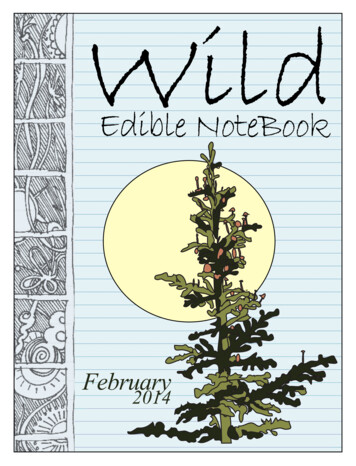
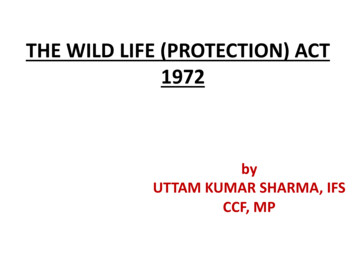
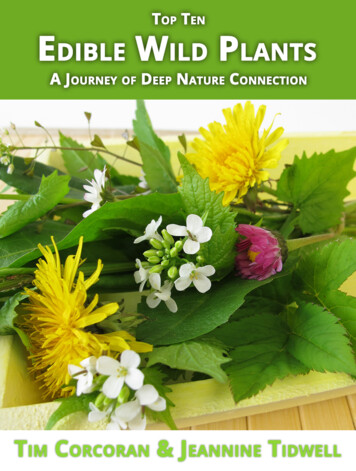
![INDEX [randycherry ]](/img/21/x-20-20tv-20fakebook-20-20hal-20leonard.jpg)
